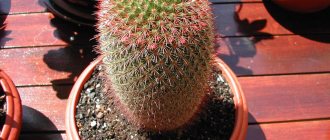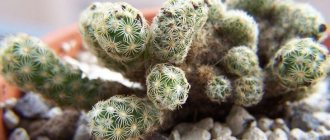general description
The trunk has a round, ribbed exterior . Since there is a similarity to a ball, the evaporation of moisture from the surface in this case is very small. And during the wet period, the ribs swell, helping the owner to absorb as much water as possible without cracking or bursting. Succulents are accustomed to living in poor, dry soil, and overwatering is extremely dangerous for them .
Flowering also depends on the amount of moisture; for desert dwellers this will not happen if the rains were not heavy or started late.
To protect from the sun, some have very thick skin , others spread out greatly to create shade for the main stem. There are also species that appear fluffy due to the large number of spines or hairs that completely cover the plant; there are no leaves .
Variety of desert cacti species (description with photo)
Cacti differ from each other in their structure, structure, color, length and shape. There are a huge number of species, and each of them has its own distinctive characteristics.
The Aporocactus cactus is a Mexican branched species; its stems form entire bushes of long ribbed shoots. The species is not very resistant to high temperatures and blooms with large bright pink flowers.
One of the smallest and “fluffiest” cacti is Aylostera. Its surface is covered with many thin soft spines that look like fur. The flowers of the cactus are orange and small.
Cleistocactus has straight vertical stems, thin spines of white or light yellow color. Small flowers in tones ranging from orange to red bloom at the tops.
Mammillaria is one of the most popular indoor cacti. Its surface is not ribbed, like many other species, but is covered with papillae, on which there are spines. Mammillaria is loved for its long flowering time.
Some cacti are distinguished by their flowers, which are uncharacteristically large and colorful for a nondescript stem. One of these is the Lobivia cactus. Its flowers have a wide variety of shades depending on the variety. The stem itself is cylindrical in shape with hard long spines.
The Parody cactus is a small, rounded cactus that differs from others in having ribs that twist into a spiral. Parody's flower blooms right at the top.
If you look at the Astrophytum cactus from above, you can compare it to a star. This is exactly the picture that the ribs of the plant make in combination with its round shape. Usually has very long and hard spines.
A cactus that looks like an ancient Aztec sculpture is, by definition, extraordinary. In Aztecium, the papillae are located along the ribs, slightly flattened, which is why the unusual shape is created.
The Blossfeldia cactus has one of the smallest sizes, and its flowers from a distance resemble daisies.
Ariocarpus is a rather strange species of cactus. Its papillae are elongated, triangular in shape and more like thorns.
Depending on the variety, Ferocactus can be either round or elongated. It also has deep ribs and long, hard, brown spines.
Cephalocereus can rightfully be called the strangest and most atypical cactus. Its spines are so thin and long that because of their white color, people began to associate it with gray hair. You have to be careful - these thorns can hurt.
The Rebutia cactus has a round, slightly flattened shape with tubercles arranged in a spiral. Usually many stems are located nearby, flowers bloom in large quantities.
Echinopsis itself does not attract much attention - it is an ordinary round cactus. But it is impossible to look at its large white flowers on a long stalk without surprise.
Cereus has the largest number of varieties. These are mainly tall, strong stems with deep ribs and small thorns. The papillae are located along the ribs, the spines are brown or gray.
The stem of Gymnocalycium is low, with a small number of ribs, and without spines. However, on top of it is a flower that itself resembles a colorful cactus.
Prickly pears come in a variety of amazing shapes, with stems resembling leaves or droplets. Each of these “leaves” is covered with very short and small spines. In addition, some types of Opuntia are eaten.
Photo
We bring to your attention photos of desert cacti:
Cactus in the desert
“Flowers are stars that fell to Earth,” this is what our distant ancestors thought. And others
Weeping grass
This magical plant is known according to ancient legends. The Dove Book says that it grew from the words.
Lilac wildflowers
In the natural conditions of fields and meadows, many herbs and flowers grow, giving them a beautiful appearance during flowering.
Wild plants
Since childhood, many of us remember riddles about wild plants, in which, as a joke.
We associate the word “desert” with endless sandy massifs scorched by the scorching sun and the complete absence of any flora. Unlike the lifeless expanses of the Karakum or Sahara, desert cacti grow in Central and Southern America because their rocky soil contains salts and minerals, but is almost completely devoid of humus. Climatic precipitation is very rare here, and in some areas it never occurs at all. Where does the water that dissolves these salts, which are so necessary for the life support of plants, come from?
How does a cactus survive in the desert?
The moisture that nourishes the roots of cacti comes from the night dew that flows down the grooves of their ribs. These unpretentious desert plants, accustomed to a meager water diet, also feed the night mists that settle on their spines. Thanks to this limited water resource, a wide variety of cacti species grow, bloom and delight local residents for years on the rocky Peruvian, Ecuadorian and Mexican soils. The roots of these amazing plants are a tuber, thickened downwards in the shape of a radish, in which moisture is stored. It does not go deep, but fancifully branches almost at the very surface. The root system of cacti is huge and takes moisture from the surface layer of the earth over an area of up to 3 meters.
The stem of this representative of the American flora owes its unusual shape to its modest water diet. To save water, the plant strives, as soon as possible, to reduce the surface of the stem to prevent moisture from evaporating from it. And, as is well known, the sphere and the cylinder have the largest volume and smallest area. Therefore, almost all desert cacti have a spherical or cylindrical shape.
To protect themselves from the hot sun, inventive cacti growing in the desert, thanks to centuries of evolution, have acquired a number of different adaptations. Many plants are covered with a thick and incredibly dense skin that protects them from overheating. During droughts, some cacti become flat and go deeper into the soil. Others have spacious ribs that cast shadows over the entire plant. The vast majority of cacti have spines or bristles, which help them withstand the scorching rays of the sun and give them a funny appearance.
If you set out to have a variety of desert cacti on your window, you need to be guided by a number of the following rules:
1. Such plants need good natural light.
2. They do not tolerate excessively wet soil and may die if watered too often. Remember! Stagnation of water, even in the hot season, not to mention cool weather, invariably leads to the death of the plant. Therefore, watering must be treated with extreme caution. It's better to underfill than overfill.
3. Do not pour water on the stem. You need to water right to the roots.
4. The water should be slightly higher than the air temperature.
3. For planting, you need to use soil rich in humus.
Growing “thorny friends” at home will allow you to touch the wonderful world of wildlife and bring you indelible aesthetic pleasure!
Features of plant care
With proper care and timely picking, cacti will look healthy and will delight your eye with their unusual color. We must not forget that cacti stand out from other house plants, so excess water in the ground can cause the death of the cactus, and summer heat and dry soil will “send” the cactus into hibernation.
In order for cacti to easily grow and bloom at home, they need low temperatures in winter, and in summer - a shaded room, moderate temperatures (up to 25 degrees Celsius) and sufficient watering.
Air temperature
The air temperature should be mild from spring to autumn. In winter, it is necessary to maintain the temperature within 15-18 degrees; some cacti have the ability to tolerate 5 degrees Celsius. However, cacti that are on the windowsill in an unheated room on cold nights are safer to move to a warmer room.
Watering and air humidity
The main rule of watering: it is better not to top up than to overfill. In the spring, watering begins to increase; in the period April - August, watering should remain the same as for ordinary house plants (provided that the room is warm and sunny) - as the soil dries out. Cacti should be watered with soft and warm water. At the end of summer, watering is gradually reduced, and from mid-autumn it is watered quite rarely and little by little (table spoons).
Cacti do not need to be sprayed (except Cleistocactus can be sprayed); on hot, stuffy days they do not spray the plant, but around it.
Soil and replanting
For cacti, as a rule, earth mixtures are used in equal parts of compost and sand with the addition of coal and peat. This soil mixture is loose, airy and quite moist. The chemical composition of the soil, for different varieties of cacti, requires the same ratios of mineral and organic components, but the acidity should be low.
Young cacti are replanted every year, 3-4 year old ones - once every couple of years. It is advisable to perform transplantation at the beginning of the growing season. The new pot should be 1 centimeter larger than the previous one. Before picking (two to three days), do not water the cactus; the soil will easily fall off the roots.
To remove a prickly cactus from a pot, wrap it in paper or wear gloves. Do not water or keep in the sun for a couple of days after picking. The choice of pot for the cactus should correspond to the size of the root system.
If the cactus has short roots, choose a low pot, but cacti with huge roots require a deeper pot. Cacti are grown in plastic pots (the soil dries out more slowly, and it is better to plant fresh plants that take root in such pots), but this is not a necessary condition; the pot can be clay (the soil dries out faster and hardens after watering) or glass (usually used for decor). Any pot must have a drainage hole to drain unnecessary water - this is probably one of the most important conditions for growing succulents.
Reproduction
Most species of desert cacti reproduce vegetatively in summer or spring. Cactus cuttings are cut (they already have rudimentary roots), dried for 2-4 days before planting in a peat-based mixture, after a short time the cactus will develop a root system.
Cacti are propagated by seeds in the same way. Growing cacti from seeds is a serious and rather painstaking job. Most importantly, purchased seeds must be disinfected in a solution of potassium permanganate. Then spread the soil in a small layer up to 1 centimeter and spread the seeds. The soil should always be moist, so it should be covered with glass or film - this will create the proper conditions for seed germination.
Based on the type of cactus and the characteristics of the seeds, the duration of germination can last from a day to a couple of months. As soon as the plants form their first spines, they should be planted in single pots in the most nutritious substrate. At the age of a couple of months, young cacti require the same care as other cacti. It is recommended to sow seeds at the end of winter so that seedlings emerge in early spring.
Cactus blossom
The flowering stage of many cacti does not coincide with the active growth stage. Some cacti (Lobivia, Parodia, Notocactus...) bloom quite often at a young age, while others, such as Opuntia and Cereus, very rarely delight with their color. Flowering of cacti can be expected at about 3-4 years of age, then they should bloom annually.
The secret of cactus flowering is in fresh shoots, which contain flowering buds, and this requires proper care in summer and winter. To encourage cactus flowering, it is extremely important to keep the plant in a tight pot.
Message 5 option
Cactus is a plant that lives primarily in tropical climates. It is distinguished by the presence of spines and the absence of leaves. Most cacti are so different from the plants we are used to that sometimes we are even surprised to see something in front of us that looks more like an alien creature. It is worth saying that cacti are in many ways similar to ordinary plants. They have the same organs as everyone else.
There is an opinion that almost all cacti grow in deserts. But this is not entirely true. Cacti grow extremely slowly, and as soon as they appeared on the surface, they would immediately be covered with sand. But deserts are different, with different annual precipitation and temperatures. There is no place on earth where only cacti grow. If we see a cactus somewhere, it means that many other plants can be found nearby. Most cacti grow in semi-deserts, tropics and steppes.
Growing a cactus at home is quite a simple task. If they can grow in the desert, then a flower pot will seem like paradise to them. However, it is worth understanding that the cactus also needs proper care. Yes, cacti can live for a long time without water, especially in winter, but, nevertheless, sometimes it is worth watering them. Cacti should be placed on window sills or on the balcony. Many people place a cactus next to their computer, thinking that this plant will help them get rid of some harmful radiation. But this is not true.
The cactus can also be used for medicinal purposes. Cactus juice has an antibacterial effect and also helps against rheumatism. According to many scientists, cactus can be used to treat headaches, stomach problems, and pieces of cactus can also be applied to a wound for speedy healing. An ordinary plant, but so many benefits! Cacti can be completely different. Their stems can be round, elongated, ribbed, etc. Not all cacti may have spines; there are also absolutely “naked” representatives. If you got a cactus with spines, then you need to be very careful with it. After all, one wrong move, and you already have a thorn sticking out of your finger, which will be very painful to get back.
If the owner of the cactus is lucky, he can observe a beautiful flowering. Flowers can be of completely different sizes, but they will certainly be beautiful and have eye-catching shades. Different cacti bloom at different times. Some can bloom almost every month, while others have to wait for years.
If you are planning to bring a cactus into your home, then you should understand that they rarely get along with other indoor plants. The point here is the conditions of detention. For example, a large number of plants require special humidity, while for a cactus this will only cause harm and suffering.
Also, do not water cacti with regular tap water. Such water is usually hard, which causes a large amount of salts to accumulate at the base of the stems, which harms the plant. In order for the cactus to feel good and please its owner for many years, it should be watered with rain or melt water. You should also use special soil, which can be purchased at garden stores.
Several interesting essays
In the story of Maxim Gorky, Old Woman Izergil, a vivid example of love for people and self-sacrifice is the legend of Danko. The work itself is filled with deep meaning, like most of the works of this author.
The epic story “Ilya Muromets and the Nightingale the Robber” describes the wishes of the people regarding the need for a defender of the weak from the misfortunes of the enemy. This was Ilya-Muromets, who defeated the evil and formidable
All school subjects can be compared to the bricks that make up our general education. They are equally important elements of this education, and it is impossible, giving preference to one, not to engage in others at all
One of the interesting genres of literature for children is the classic Russian folk tale. These tales contain witchcraft, magical transformations, miracles, and adventures.
Reproduction and transplantation
The most affordable and effective ways to propagate cacti are by shoots (or babies) and cuttings.
When propagating by shoots, it is necessary to separate the baby from the mother plant (usually the shoot can be rooted if it has reached a length of 1.5-2 cm). The shoot is then placed over a container filled with water.
Important : water should not touch the plant! It is better if the distance between the moisture and the shoot is 5-7 cm. Water must be added as it evaporates. The shoot will be ready for planting once roots have formed.
When propagating by cuttings (this method is used less frequently, usually if the plant is sick and cannot be cured), healthy parts of the cactus are cut off with a sharp, disinfected blade. After this, the cut end of the handle must be sharpened and dried for a week. After this, it can be planted in the ground. For more active root formation, you can soak the cuttings in the “Kornevin” solution for 1.5–3 hours, and then dry them for 2–3 days.
Due to their slow growth, cacti do not require replanting very often. It is necessary in cases where the soil is completely depleted, contaminated, or if the plant has grown so large that it needs a larger pot.
To avoid injury during transplantation, you need to use thick gloves. The pot with the cactus must be carefully turned over and the flower removed along with the earthen lump. The remaining soil should be carefully shaken off. The cactus should be replanted in disinfected, well-drained soil. After transplantation, the plant is not watered for 5-7 days.











